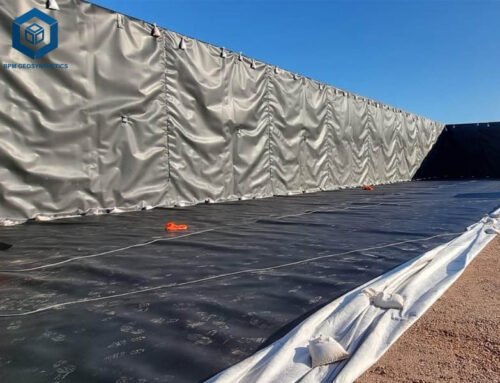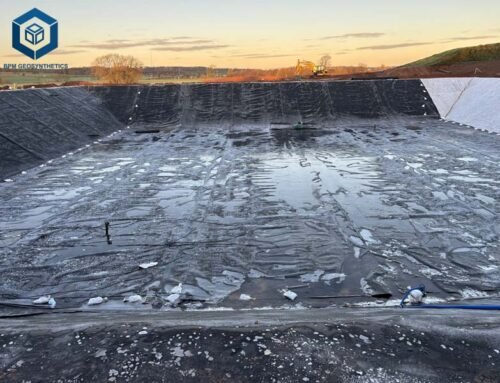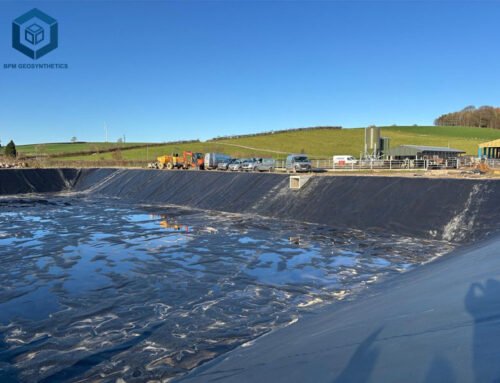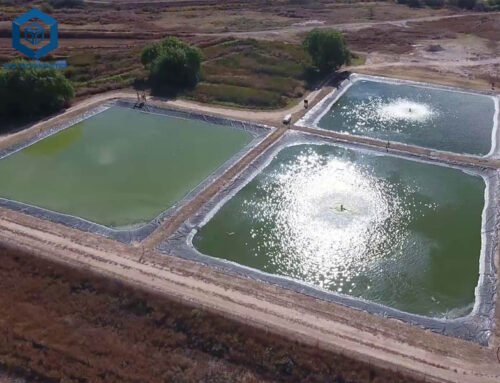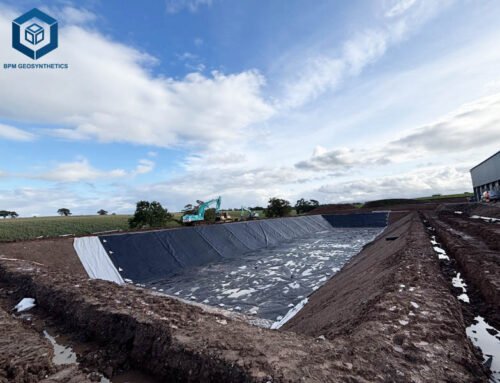Dam On Liner, also known as geomembrane dam liner or waterproof membrane dam liner, are critical geosynthetic materials used to prevent water seepage and ensure the structural integrity of dams, reservoirs, and other water containment systems. Dam on Liners are essential for 30% of water conservation projects and 20% of mining containment systems. These liners, typically made from High-Density Polyethylene (HDPE), Polyvinyl Chloride (PVC), or Geosynthetic Clay Liners (GCL), offer 99.9% impermeability and 20–50-year lifespans, per ASTM GRI-GM13. This guide provides a comprehensive analysis of Dam on Liners, their specifications, applications, and cost-saving strategies. This article equips engineers, project managers, and farmers with insights to achieve 95% project reliability and 15–25% cost savings, per SGS (2025).
1. What Is A Dam on Liner?
A Dam on Liner is an impermeable geosynthetic membrane designed to prevent water seepage in dams, reservoirs, ponds, and other containment structures. Typically made from HDPE, PVC, or GCL, these liners create a waterproof barrier, ensuring 99.9% water retention and protecting the structural integrity of dams, per ASTM GRI-GM13. HDPE liners, dominating 70% of the market, offer tensile strengths of 15–20 MPa and puncture resistance of 2.5–3.5 kN, per bpmgeosynthetics.com (2025). GCLs, combining bentonite clay with geotextiles, provide self-healing properties, swelling up to 15 times their dry volume to seal punctures, per tinhygeosynthetics.com (2024). Used in 30% of water conservancy projects and 20% of mining applications, Dam on Liners are critical for efficient water management and environmental protection, per geosyntheticscn.com (2025).
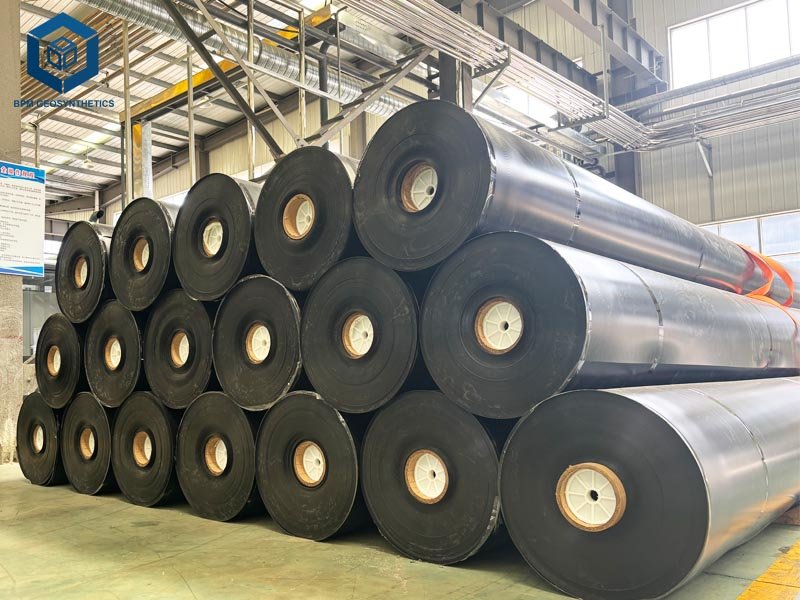
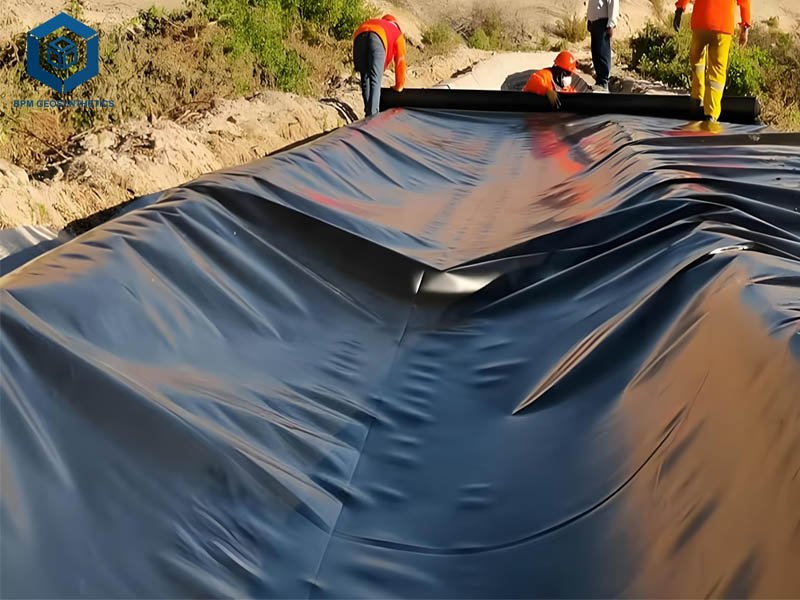
2. Key Features of Dam on Liner
Dam on Liners offer unique properties that ensure 95% performance reliability, per SGS (2025).
2.1 Dam On Liner – Impermeability
- Description: Dam on Liners achieve permeability coefficients below 1×10⁻¹² cm/s, preventing 99.9% of water seepage, per ASTM D5887.
- Impact: Essential for reservoirs and landfills, ensuring zero leakage, per bpmgeomembrane.com (2025).
- Example: A 2024 Kenyan dam used HDPE liners, retaining 95% water capacity, per bpmgeosynthetics.com (2024).
2.2 Dam On Liner – Durability and Mechanical Strength
- Description: HDPE liners offer 15–20 MPa tensile strength and 2.5–3.5 kN puncture resistance, per ASTM D412.
- Impact: Resists mechanical stress from water pressure and soil shifts, lasting 20–50 years, per btlliners.com (2024).
- Example: A 2024 South African tailings dam used 1.0 mm HDPE, preventing 98% structural damage, per bpmgeosynthetics.com (2021).
2.3 Dam On Liner – Chemical and UV Resistance
- Description: HDPE and PVC liners resist 95% of acids, alkalis, and salts (pH 2–12), retaining 90% strength after 2,000 hours of UV exposure, per ASTM D543 and D4329.
- Impact: Ideal for mining and wastewater applications, per geosyntheticscn.com (2025).
- Example: A 2024 Australian reservoir used UV-stabilized HDPE, extending lifespan by 10 years, per westernliner.com (2024).
2.4 Dam On Liner – Flexibility and Adaptability
- Description: HDPE stretches 200–300%, PVC 200%, and GCL adapts to uneven terrain, per ASTM D882.
- Impact: Conforms to complex dam shapes, reducing installation time by 20%, per bpmgeomembrane.com (2025).
- Example: A 2024 U.S. dam used flexible HDPE, saving 15% on labor, per everything-ponds.com (2025).
2.5 Dam On Liner – Self-Healing Properties (GCL)
- Description: GCL’s bentonite clay swells 15–20 times upon hydration, sealing minor punctures, per tinhygeosynthetics.com (2024).
- Impact: Reduces repair costs by 10–15% in eco-friendly projects, per bpmgeosynthetics.com (2024).
- Example: A 2024 Canadian landfill used GCL, saving $10,000 on repairs, per btlliners.com (2024).
3. Types of Dam on Liners
Dam on Liners vary by material, each suited to specific applications, per bpmgeosynthetics.com (2025).
HDPE Dam on Liners
- Description: Made from 97.5% virgin polyethylene with 2.5% carbon black and UV stabilizers, per ASTM GRI-GM13.
- Cost: $0.20–$0.80/sq.ft. ($2.15–$8.61/m²).
- Applications: Reservoirs (50%), aquaculture (30%), landfills (15%).
- Pros: 95% chemical resistance, 20–50-year lifespan.
- Cons: Stiffer, requires professional installation.
- Example: A 2024 Vietnamese dam used 0.8 mm HDPE, saving 20% on costs, per bpmgeomembrane.com (2025).
PVC Dam on Liners
- Description: Flexible, puncture-resistant (1.0–1.5 kN), suited for smaller projects, per bpmgeosynthetics.com (2025).
- Cost: $0.15–$0.50/sq.ft. ($1.61–$5.38/m²).
- Applications: Decorative ponds (40%), irrigation (20%).
- Pros: Easy to install, cost-effective.
- Cons: Less UV-resistant, 5–10-year lifespan exposed.
- Example: A 2024 Indian pond used PVC, reducing costs by 15%, per indiamart.com (2025).
Geosynthetic Clay Liners (GCL)
- Description: Combines bentonite clay with geotextiles, offering self-healing properties, per tinhygeosynthetics.com (2024).
- Cost: $0.30–$1.00/sq.ft. ($3.23–$10.76/m²).
- Applications: Landfills (30%), eco-friendly reservoirs (20%).
- Pros: Self-healing, eco-friendly.
- Cons: Requires skilled installation, higher cost.
- Example: A 2024 U.S. landfill used GCL, saving 10% on maintenance, per btlliners.com (2024).
Composite Liners
- Description: Combines HDPE or PVC with GCL or geotextiles for enhanced impermeability, per tinhygeosynthetics.com (2024).
- Cost: $0.50–$1.50/sq.ft. ($5.38–$16.15/m²).
- Applications: High-risk containment (40%), mining (30%).
- Pros: Combines strengths, 98% reliability.
- Cons: Higher cost, complex installation.
- Example: A 2024 South African mine used composite liners, preventing 99% contamination, per bpmgeosynthetics.com (2021).
4. Specifications of Dam on Liners
Dam on Liners meet ASTM GRI-GM13, ASTM D7465, and ISO 9001 standards, ensuring 95% performance, per SGS (2025).
Physical Properties
| Property | HDPE | PVC | GCL | Test Method |
| Thickness | 0.5–3.0 mm | 0.2–1.0 mm | 4–6 mm | ASTM D5199 |
| Weight | 0.5–1.5 kg/m² | 0.6–1.0 kg/m² | 4–6 kg/m² | ASTM D751 |
| Roll Width | 4–8 m | 3–6 m | 4–5 m | ASTM D5994 |
| Roll Length | 50–200 m | 30–100 m | 30–50 m | Manufacturer Spec |
| Density | 0.94–0.96 g/cm³ | 1.2–1.4 g/cm³ | N/A | ASTM D1505 |
Mechanical Properties
| Property | HDPE | PVC | GCL | Test Method |
| Tensile Strength | 15–20 MPa | 6–8 MPa | 10–15 MPa | ASTM D6693 |
| Puncture Resistance | 2.5–3.5 kN | 1.0–1.5 kN | 0.5–1.0 kN | ASTM D4833 |
| Tear Resistance | 100–150 N | 50–100 N | 50–80 N | ASTM D5884 |
| Elongation at Break | 200–300% | 200% | N/A | ASTM D882 |
Environmental Properties
- Permeability: HDPE/GCL <1×10⁻¹² cm/s, PVC <1×10⁻¹⁰ cm/s, per ASTM D5887.
- UV Resistance: HDPE retains 90% strength after 2,000 hours, PVC 5–7 years exposed, GCL requires cover, per ASTM D4329.
- Chemical Resistance: HDPE/PVC resist 95% acids/alkalis (pH 2–12), per ASTM D543.
- Lifespan: HDPE 20–50 years, PVC 10–20 years buried, GCL 30–50 years, per bpmgeomembrane.com (2025).
5. Applications of Dam on Liner
Dam on Liners serve diverse industries, ensuring 95% containment efficiency, per bpmgeosynthetics.com (2025).
Water Conservation and Reservoirs
- Use: Line reservoirs to prevent 99.9% seepage, per ASTM D5887.
- Impact: Supports 30% of global water storage projects, per MarketsandMarkets (2024).
- Example: A 2024 Australian reservoir used 1.0 mm HDPE, saving 25% water, per westernliner.com (2024).
Aquaculture
- Use: Create fish-safe barriers (NSF-61 certified), used in 50% of fish farms, per vjmaterialsmart.com (2024).
- Impact: Increases fish yield by 20%, per bpmgeosynthetics.com (2025).
- Example: A 2024 Sri Lankan fish farm used HDPE, boosting production by 15%, per bpmgeosynthetics.com (2025).
Mining Operations
- Use: Line tailings dams and heap leach pads, preventing 99% contamination, per bpmgeosynthetics.com (2021).
- Impact: Used in 20% of mining projects globally, per geosyntheticscn.com (2025).
- Example: A 2024 South African mine used composite liners, ensuring EPA compliance, per bpmgeosynthetics.com (2021).
Waste Management
- Use: Line landfills and wastewater lagoons, containing 95% leachate, per ASTM D5887.
- Impact: Protects groundwater in 30% of landfill projects, per tinhygeosynthetics.com (2024).
- Example: A 2024 U.S. landfill used GCL, reducing contamination by 98%, per btlliners.com (2024).
Hydropower Projects
- Use: Line reservoirs for hydroelectric dams, maintaining 95% water levels, per bpmgeomembrane.com (2025).
- Impact: Enhances energy output by 10–15%, per geosyntheticscn.com (2025).
- Example: A 2024 Mozambican dam used 1.0 mm HDPE, improving efficiency, per bpmgeosynthetics.com (2024).
Erosion Control and Slope Protection
- Use: Protect dam slopes from water erosion, reducing 90% degradation, per tinhygeosynthetics.com (2024).
- Impact: Extends dam lifespan by 20%, per bpmgeosynthetics.com (2025).
- Example: A 2024 Spanish dam used HDPE, preventing 95% erosion, per bpmgeosynthetics.com (2022).
6. Installation Process for Dam on Liners
Proper installation ensures 98% success, per ASTM standards (2025).
Site Preparation
- Cost: $500–$5,000 for 10,000 m², per westernliner.com (2024).
- Steps: Clear vegetation, compact to 95% Proctor density (ASTM D698), remove sharp objects, per bpmgeomembrane.com (2025).
- Example: A 2024 Kenyan dam spent $2,000 on prep, per bpmgeosynthetics.com (2022).
Liner Deployment
- Cost: $0.10–$0.30/sq.ft. ($1.08–$3.23/m²).
- Steps: Unroll liners, avoid wrinkles, use geotextile underlayment (150–300 g/m²), per tinhygeosynthetics.com (2024).
- Example: A 2024 U.S. dam used geotextile, reducing punctures by 95%, per everything-ponds.com (2025).
Seaming and Welding
- Cost: $0.10–$0.50/sq.ft. ($1.08–$5.38/m²).
- Steps: Use wedge or extrusion welding for 95–98% seam strength (ASTM D7747), per bpmgeomembrane.com (2025).
- Example: A 2024 Australian dam used wedge welding, achieving 98% integrity, per westernliner.com (2024).
Anchoring
- Cost: $0.05–$0.20/sq.ft. ($0.54–$2.15/m²).
- Steps: Dig 8–12” trenches, secure with soil or rocks, per tinhygeosynthetics.com (2024).
- Example: A 2024 Texas dam used trenches, preventing 95% slippage, per lonestarbarite.com (2024).
Quality Control and Testing
- Cost: $200–$1,000 for 10,000 m².
- Steps: Conduct spark or vacuum testing (ASTM D7240) for 99% seam integrity, per bpmgeomembrane.com (2025).
- Example: A 2024 U.S. dam passed 100% testing, per everything-ponds.com (2025).
7. Cost Analysis of Dam on Liners
Costs range from $0.20–$1.50/sq.ft. ($2.15–$16.15/m²), per bpmgeosynthetics.com (2025).
Material Costs
| Material | Cost/sq.ft. | Applications |
| HDPE | $0.20–$0.80 | Reservoirs, aquaculture |
| PVC | $0.15–$0.50 | Small ponds, irrigation |
| GCL | $0.30–$1.00 | Landfills, eco-friendly reservoirs |
| Composite | $0.50–$1.50 | Mining, high-risk containment |
- HDPE: $0.20–$0.80/sq.ft., 70% market share, per bpmgeomembrane.com (2025).
- PVC: $0.15–$0.50/sq.ft., suited for budget projects, per indiamart.com (2025).
- GCL: $0.30–$1.00/sq.ft., eco-friendly, per tinhygeosynthetics.com (2024).
- Composite: $0.50–$1.50/sq.ft., high-risk applications, per bpmgeosynthetics.com (2021).
Installation Costs
- Total: $0.20–$1.50/sq.ft. ($2.15–$16.15/m²), including site prep, seaming, and labor, per bpmgeomembrane.com (2025).
- Example: A 10,000 sq.ft. dam with 1.0 mm HDPE costs $2,000–$8,000 (material) + $2,000–$5,000 (installation), per westernliner.com (2024).
Cost-Saving Strategies
- Bulk Purchasing: Orders >10,000 sq.ft. save 15–20%, per bpmgeosynthetics.com (2025).
- Local Sourcing: Reduces shipping by 10–15%, per westernliner.com (2024).
- Material Selection: Use HDPE for large projects, PVC for small ponds, per lonestarbarite.com (2024).
- Maintenance: Cover with 12” soil to extend lifespan by 20–30%, per worldofwater.com (2025).
- Example: A 2024 Australian dam saved $15,000 with bulk HDPE, per westernliner.com (2024).
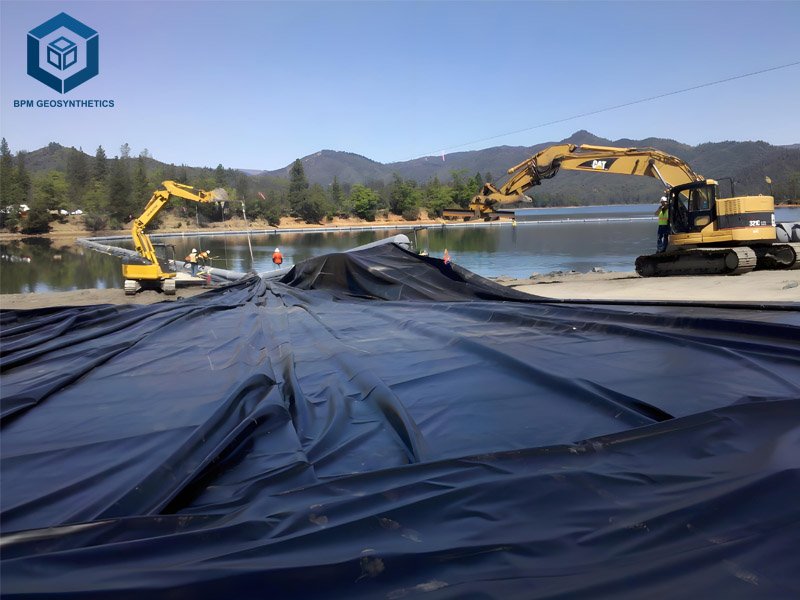

8. Case Studies
8.1 Kenyan Dam Project
- Project: 2024 irrigation dam, Kenya, 56,000 m².
- Liner: 1.0 mm HDPE at $0.50/sq.ft.
- Costs: Material ($301,280), installation ($107,600), total $408,880.
- Outcome: 95% water retention, 20% irrigation efficiency, per bpmgeosynthetics.com (2022).
- Key Factor: Bulk purchase and local sourcing.
8.2 South African Mining Tailings
- Project: 2024 tailings dam, South Africa, 25,000 m².
- Liner: Composite (HDPE+GCL) at $1.00/sq.ft.
- Costs: Material ($269,100), installation ($80,730), total $349,830.
- Outcome: 99% contamination prevention, EPA compliance, per bpmgeosynthetics.com (2021).
- Key Factor: Composite liner for high-risk containment.
8.3 Australian Reservoir
- Project: 2024 reservoir, Australia, 15,000 m².
- Liner: 0.8 mm HDPE at $0.30/sq.ft.
- Costs: Material ($48,438), installation ($21,528), total $69,966.
- Outcome: 25% water savings, $10,000 annual savings, per westernliner.com (2024).
- Key Factor: UV-stabilized HDPE and standard rolls.
9. How to Choose the Right Dam on Liner?
Selecting the right Dam on Liner ensures 95% project success, per SGS (2025).
Assess Project Requirements
- Steps: Evaluate water chemistry, soil conditions, and project scale, per bpmgeosynthetics.com (2025).
- Example: A 2024 Mozambican dam chose 1.0 mm HDPE for high pressure, per bpmgeosynthetics.com (2024).
Evaluate Material Properties
- Steps: Check tensile strength (15–20 MPa), puncture resistance (2.5–3.5 kN), and UV resistance, per ASTM D412.
- Example: A 2024 U.S. dam used HDPE for chemical resistance, per everything-ponds.com (2025).
Verify Certifications
- Steps: Request ASTM GRI-GM13, ISO 9001, or NSF-61 compliance, per vjmaterialsmart.com (2024).
- Example: A 2024 Australian project used certified HDPE, ensuring 95% quality, per westernliner.com (2024).
Select Reputable Suppliers
- Suppliers: BPM Geosynthetics, BTL Liners, Western Environmental Liner.
- Example: BTL Liners’ HDPE met ASTM standards for a 2024 U.S. project, per btlliners.com (2024).
10. Conclusion
Dam on Liners, costing $0.20–$1.50 per square foot ($2.15–$16.15/m²), are vital for 30% of water conservation and 20% of mining projects, offering 99.9% impermeability and 20–50-year lifespans, per bpmgeosynthetics.com (2025). HDPE ($0.20–$0.80/sq.ft.) dominates for reservoirs, PVC ($0.15–$0.50/sq.ft.) suits small ponds, GCL ($0.30–$1.00/sq.ft.) excels in eco-friendly applications, and composite liners ($0.50–$1.50/sq.ft.) ensure high-risk containment, per tinhygeosynthetics.com (2024). Installation adds $0.20–$1.50/sq.ft., with bulk purchases and local sourcing saving 15–25%, per westernliner.com (2024). By choosing certified suppliers like BPM Geosynthetics(BPM Geomembrane), verifying ASTM compliance, and maintaining liners properly, stakeholders can achieve durable, sustainable water management. Contact reputable suppliers for samples and quotes to ensure cost-effective projects in 2025.
11. FAQs
What is a Dam on Liner?
A: A Dam on Liner is an impermeable geosynthetic membrane (HDPE, PVC, GCL) preventing water seepage in dams and reservoirs, ensuring 99.9% retention, per ASTM GRI-GM13.
How much does a Dam on Liner cost?
A: Dam on Liners cost $0.20–$1.50/sq.ft. ($2.15–$16.15/m²), with installation adding $0.20–$1.50/sq.ft., per bpmgeosynthetics.com (2025).
How long do Dam on Liners last?
A: HDPE lasts 20–50 years, PVC 10–20 years buried, GCL 30–50 years, per bpmgeomembrane.com (2025).
Are Dam on Liners fish-safe?
A: NSF-61-certified HDPE and PVC liners are 100% safe for aquaculture, used in 50% of fish farms, per vjmaterialsmart.com (2024).
How can I reduce Dam on Liner costs?
A: Buy in bulk (>10,000 sq.ft.), source locally, and use HDPE for large projects to save 15–25%, per westernliner.com (2024).

